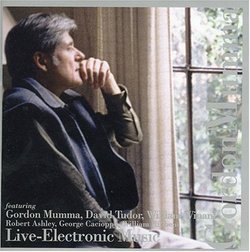| All Artists: Gordon Mumma, Robert Ashley, George Cacioppo Title: Live-Electronic Music Members Wishing: 2 Total Copies: 0 Label: Tzadik Release Date: 1/22/2002 Album Type: Live Genres: Dance & Electronic, New Age, Pop, Classical Styles: Electronica, Techno, Vocal Pop, Chamber Music, Historical Periods, Modern, 20th, & 21st Century, Instruments, Electronic Number of Discs: 1 SwapaCD Credits: 1 UPC: 702397707424 |
Search - Gordon Mumma, Robert Ashley, George Cacioppo :: Live-Electronic Music
 | Gordon Mumma, Robert Ashley, George Cacioppo Live-Electronic Music Genres: Dance & Electronic, New Age, Pop, Classical
|
Larger Image |
CD Details |
CD ReviewsNeglected pioneer in Live electronics. scarecrow | Chicago, Illinois United States | 03/07/2007 (5 out of 5 stars) "Today we take for granted the genre of Live Electronics, we think it is a new concoction by those who today traverse its content, from free jazz
"livers" to post-minimalists,(ad nauseum) to plural performance mixtures of the neo-liberal order. The early group ONCE(ring any bells?) is often forgotten but they were the first in the USA to experiment and make interesting useful contributions to what we know now as the genre live electronics. We are talking about all wonderful composers, creators and performers in their own right who perhaps took the Cage non-aesthetic/aesthetic its furthest down the road to(where-else) beauty. David Behrman, Alvin Lucier, Robert Ashley and Gordon Mumma was ONCE. Mr. Mumma you may know was an inspiration to the pit-music accompanying the Merce Cunningham Dance Company, along with John Cage and David Tudor. Three such formidable players in the pit create incredible things themselves. But prior to all this Mumma had a modest body of work all to himself.Even pointillistic "offerings" for piano solo.He was also a devote experimentor in making his own electrical components as interfacing with live situations,mixers, blenders and transducers;all a breath of fresh conceptual air from the frozen-Moog/Buckla means that academia pounced on as a new means of exploitation of the "studio-product"If you study composition with Mr. Mumma the materials often require purchase of plans of electrical circuitry, lots of wire and a wire-cutter. Here you have a good sample of Mumma's early work. He was himself a French Horn player that he often performed in ONCE performances at the University of Michigan in the Sixties. He doesn't hold back and knows the more primordialpowerful qualities of the Horn(s) and its brethren.The titles here suggest this this primitiveness, much like the early work of Pollock the myth/iconic prior to his celebrity status.These composers have no such luck however. The use of live electronics has a meaning here to create beauty,some counter-fource to the relative "ugliness" of the European counterpart of Stockhausen,Ligeti. ONCE and Mumma all seem quite fascinated with the sustained timbre, and how it becomes transformed over time. It is the most interesting timbre to listen to for in fact you can traverse and follow its orientation and demise in real durational time. You can't help feeling in a sense that this music does need a visual stimulant, something else in the lifeworld to sustain it, that is the Cage-means I suppose and what it does to this process kind of music making. The scores themselves are for the most part elaborate instructions with graphics; wonderful to contemplate just themselves. This is a neglected part of the American experiment in music, one that should be looked at again and again." |

 Track Listings (5) - Disc #1
Track Listings (5) - Disc #1